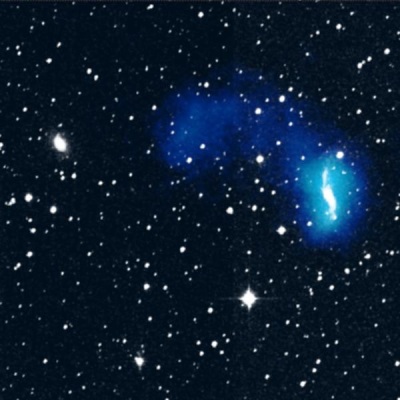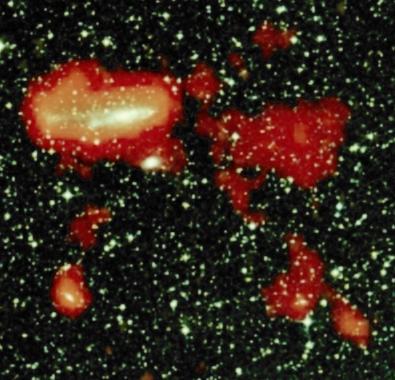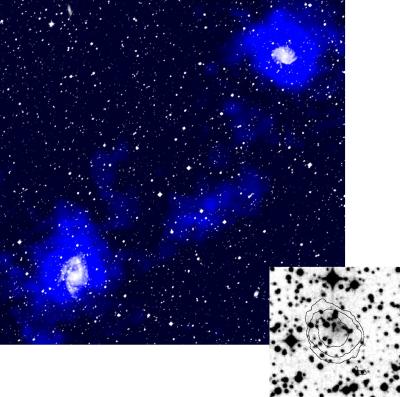HI tidal tails, bridges and Clouds
|
B. S. Koribalski (ATNF) Neutral hydrogen gas (HI) is abundant in most galaxies, but it is also found well outside their stellar envelopes where it contributes to the intergalactic medium. Prominent nearby examples of intergalactic gas include the Magellanic Stream and extended HI bridges in the M81 group of galaxies. Koribalski and her collaborators are using observations taken with the Compact Array to study the HI gas found in the outskirts of galaxies and between galaxies. The data are being used to investigate how HI may be stripped by tidal forces from the parent galaxies into the intergalactic medium and how much HI is present in intergalactic gas. The smooth, extended HI disks seen in normal spiral galaxies are dynamically very different from other extended HI distributions. Galaxies with HI tails/plumes are generally peculiar and the location and kinematics of their outer HI component are shaped by galaxy collisons, mergers or tidal interactions. One of the best resources for seeing the peculiar HI distributions in galaxies is the HI Rogues Gallery compiled by Hibbard et al. (ASP Conf. Ser., 240, 659, 2001). This collection of images shows extended gas envelopes around some normal and peculiar galaxies, tidal tails/bridges in interacting or merging galaxy systems, large-scale rings around early type galaxies, and detached clouds at varying distances from associated galaxies. Numerical simulations to study what happens to tidal debris over a long period of time have shown that a large fraction of the ejected HI gas will fall back onto the parent galaxy. The closest material falls back fastest, while more distant debris returns more slowly to accrete at larger distances from the galaxy centre. The simulations show that there is sufficient time for the slowly-returning material and any escaped gas to form bound entities and, potentially, stars. Some of these star-forming clumps may build new galaxies, such as tidal dwarf galaxies. Some galaxies have very large HI envelopes extending way beyond their stellar distribution. The extended gas distributions show many different structures ranging from smooth disks to chaotic extensions. Because of their large extent, the outer neutral hydrogen disks are much more affected by tidal interactions than the stellar disks and are therefore an excellent tracer of the tidal forces. Collisions of galaxies with extended HI envelopes lead to large HI extensions, tails and bridges which can be found out to large distances from the galaxy centre. Recycling and re-accretion of these distant debris are important for the evolution of these systems. Figures 1-3 show Compact Array images that illustrate some excellent examples of peculiar and/or interacting galaxies. These have extended HI bridges or plumes that do not appear to have any stellar content. Figure 1 shows a one-sided, diffuse HI cloud near the peculiar spiral galaxy IC 2554 which lies at a distance of approximately 16 million parsecs from the Milky Way. The prominent plume emerging to the east of this galaxy is possibly caused by an interaction with the massive elliptical galaxy NGC 3136B. The plume has an extent of about 30 kiloparsecs and contains about a third of the total HI mass of the system (2x109 solar masses). Figure 2 shows the HI distribution towards the peculiar spiral galaxy NGC 3263. This is a member of the NGC 3256 galaxy group at a distance of 37.6 million parsecs. Extended HI emission is seen around the galaxy itself, while a spectacular HI cloud of size approximately 175 x 100 kiloparsecs is seen to the west (right) of the galaxy. This cloud has an HI mass of approximately 109 solar masses. The dwarf galaxy WPV 060 which appears to be associated with an HI peak towards the south-western end of the cloud, could be a young galaxy formed out of the far-reaching tidal debris. Detached HI clouds have been seen in many galaxy groups. These may constitute the gaseous material ejected furthest from the host galaxy and now disconnected from gas that has already returned. Figure 3 shows a spectacular example of this process. The HI distribution reveals a two-stranded bridge that spans the space between the galaxies NGC 6221 and NGC 6215, over a projected distance of nearly 100 kiloparsecs. The bridge has an HI mass of at least 1.4x108 solar masses. The NGC 6221/15 group also contains three HI-rich dwarf galaxies, one of which (Dwarf 3) is indicated in the inset of Figure 3. The only intergalactic HI gas cloud detected in the HIPASS Bright Galaxy Catalog lies at a projected separation of 250 kiloparsecs from the galaxy NGC 2442 (distance = 15.5 Mpc) which is part of a loose group of galaxies. The cloud, HIPASS J0731-69, for which no optical counterpart has been detected, has an HI mass of 109 solar masses. |
|



